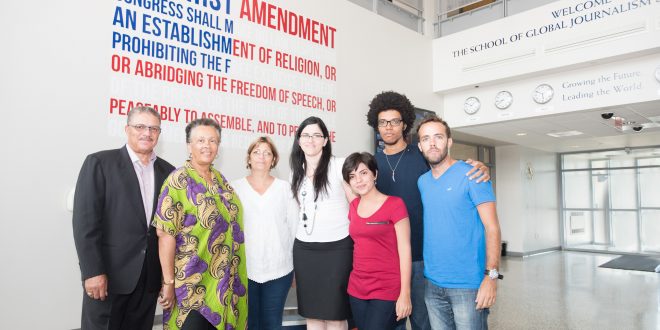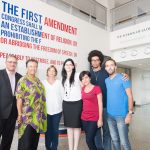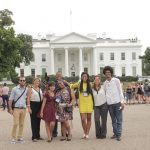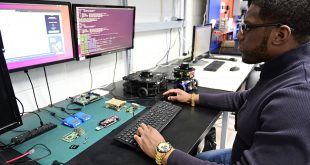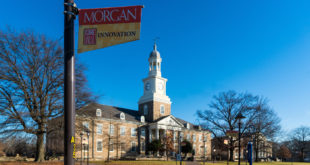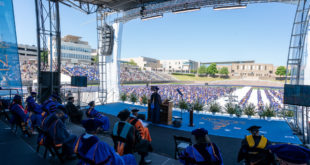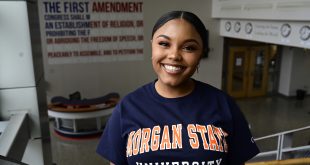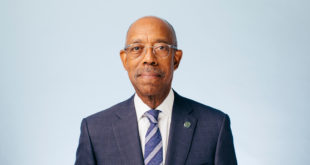Four students from the School of Global Journalism & Communication (SGJC) spent the summer shooting a documentary with students from the University of Havana to capture the interaction between Cuban and American collegiate students learning about each other’s cultures.
In June, seniors Katia Jordan, Kendra Hawkins, Devonte King and Duane Saunders Jr., who graduated in May 2016, spent a week in Cuba, along with several SGJC faculty and university officials, including Assistant Provost Anotinette Coleman, and a number of media professionals as part of a delegation led by SGJC Dean DeWayne Wickham.
In early August, a small delegation of three students and the assistant dean from the Facultad de Comunicación at the University of Havana came to Morgan to film the second part of the project.
“Being from the U.S., this trip provided us with an opportunity to get out of our comfort zones and experience firsthand how Cubans lived every day,” Katia Jordan said after the first leg of the trip.
“One thing that stuck out to me was the constant interactions that take place between Cubans. Because WiFi is not as accessible there as it is in America everyone actually speaks to each other when out. It was a refreshing part of the culture,” Hawkins said.
Production in June was weighed down a bit by several straight days of rain, which required the SGJC students to find creative ways to protect their equipment, including wrapping cameras in plastic and using umbrellas as reinforcement. “Having to carry all of our gear, and squeeze into cabs” was also an aspect of filming that Saunders found challenging.
There were few communication problems between the groups because the Cuban students were quite fluent in English. In one of their first getting-to-know-you exercises, the students took paper and drew pictures describing their perceptions of each other’s country. Most of it was lighthearted and humorous, but among the more serious exchanges about was the U.S. students’ perception that Cuba, as a communist country, was a very militaristic place. The tables were turned, however, when the Cuban students asked about gun tolerance in the States. They were under the impression that a majority of Americans carried guns, and they had a lot of questions about the nation’s gun control policies.
Visiting Baltimore and the region was even more eye-opening.
“The organization of things, the way everything is designed to make life easier for people, really surprised me,” said Randdy Fundora, who was his school’s valedictorian at the University of Havana.
Cuba has the Malecón, a seawall, and roadway that stretches nearly 5 miles along the coast from the mouth of Havana Harbor in Old Havana to Vedado, a lovely neighborhood near the central business district of Havana. The Malecón is a great place to see Cubans from all walks of life from fishermen, young couples and families at various points along the way.
Baltimore has the Inner Harbor retail district. While not as long as the Malecón, the water was still a draw for the Cuban visitors.
“My favorite place in town was the bay, to see people walking everywhere, the family, children, couples,” Fundora said. “It was very exciting to see a piece of the rubble of 9-11 [at the Maryland 9/11 Memorial] and the tall buildings near the bay.”
The Morgan students said that before leaving for Cuba, they thought they had a clear purpose and defined plan, but found instead that they learned far more about themselves.
They said media influences had led them to expect far more differences than similarities between their cultures, but that was not the case. They found their Cuban counterparts to be athletes, advocates, artists, and most importantly a people who are proud of who they are where they come from, just as Americans are.
“I learned that I’m blessed beyond measure with amenities like the Internet. But the real connection is one without technology,” said King, who got a double exposure to Cuba as a member of the Morgan State University Choir, which returned from Cuba just days before the SGJC group departed. “Overall, we learned to be thankful for the resources we do have and to not be crippled by luxuries; we learned that team work is an essential part of any and all productions.”
“America, like Cuba, is a great country and the chance to see how its people live and think, share the places they go, dance with their music on the street and to hear how they speak about my country and how they are interested in knowing more about us opens a great opportunity for knowing each other, for changing the perception of years and years talking about an ‘enemy’ that is not such enemy,” said Max Barbosoa Miranda, a professor and 2015 graduate of the University of Havana.
“This is the best part of this documentary film, the best part of both visits: American students and professors coming to Cuba, and us going to U.S., opens the doors to the opportunities of acknowledging the things that make us different but, equally, allows us to work together for a future that is starting now.”
You can read more about the SGJC students’ Cuba project online.
Recap submitted by Jackie Jones, assistant dean for programs and chairman of the Department of Multimedia Journalism in the School of Global Journalism and Communications.
 Morgan State University Newsroom Morgan State University
Morgan State University Newsroom Morgan State University
